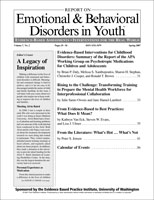Complete Issue
Author: Allison B. Randel.
Source: Volume 15, Number 03, Summer 2015 , pp.53-76(24)

< previous article |return to table of contents
Abstract:
This special issue of the Report on Emotional & Behavioral Disorders in Youth is focused on physical activity and the impact it can have for youth with psychological difficulties. In the past two decades, childhood obesity has become a significant public health concern (Ogden et al., 2014; Perrin et al., 2007), with national estimates showing the prevalence of obesity among all children to be approximately 16.9% (Flegal et al., 2012; Ogden et al., 2012, 2014). Health and psychological consequences of obesity include a variety of problems such as diabetes, cardiovascular disease, stroke, certain cancers, social isolation and discrimination, and other mental health concerns (Berenson, 2012; Puhl & Brownell, 2001; Reilly et al., 2003). In addition, the current financial burden related to medical costs and treatment for obesity in the United States is expected to increase by $48 billion to $66 billion a year (Wang et al., 2011). In recognition of the positive impact physical activity can have on reducing childhood obesity, national physical activity guidelines have suggested that all children should engage in physical activity for at least 60 minutes each day (World Health Organization, 2010). It has been found, however, that children are currently not meeting these recommendations (Matthews et al., 2008; Metcalf et al., 2008; Riddoch et al., 2007). The first article, by Randel and colleagues, describes a pilot multimodal summer camp that focuses on physical activity and social skills for youth with ASD and other developmental disorders in order to increase overall health and wellness. The camp, called Camp PALS (Fostering Physical Activity and Life Skills for Youth), was designed to improve behavioral regulation, social competence, and health behaviors based on gaps in services identified by parents as well as in the literature. Youth ages five to 18 attended the two-day-a-week camp in Columbia, South Carolina, and camp activities consisted of sports, social skills, and nutrition lessons that had been modified using best-practice interventions for youth with developmental disorders. Applied behavior analysis (ABA) techniques, along with structured teaching, modeling, and visual supports, were the primary therapeutic methods used. The goals of the camp were to enhance overall health and social skills, as well as to provide youth with a positive summer experience within a supportive environment. The purpose of this article is to describe an innovative camp for youth with developmental disorders in order to encourage other researchers and clinicians to develop guidelines for similar summer programs. The second article, by Brazendale and colleagues, explores the relationship between children’s enjoyment and perceived competence in physical education (PE) and the effects these factors have on physical activity outside of school. One hundred children in the fifth through eighth grades completed questionnaires pertaining to their enjoyment and perceived competence in PE and their participation in physical activity outside of school (seven-day recall). Results indicated a positive correlation between enjoyment in PE and perceived competence in PE. In addition, children with higher perceptions of competence in school PE reported greater participation in physical activity outside of the school environment. Enjoyment alone in PE had no statistical significance, however, in determining physical activity outside of school. Males reported significantly higher enjoyment in PE than females. The findings suggest that PE practitioners should consider promoting children’s perceived competence through the planning and implementation of developmentally appropriate lessons and strategies. Motivation theories suggest using a task-orientated mastery approach to produce positive development in these areas. Adopting such an approach has been shown to contribute toward feelings of enjoyment and intrinsic motivation, thereby encouraging children to seek out and sustain regular physical activity and, by consequence, a healthier lifestyle. The third article, by Schoffman and Turner-McGrievy, examines the complex relationship between recreational media use and four indicators of emotional health (sadness, boredom, getting in trouble, and happiness at school). Data from a nationally representative sample of U.S. eight to 18 year olds (n = 1,703) were analyzed, with bivariate associations describing the relationship between each emotional health indicator and recreational media use. Multiple linear regression tested the association between all four emotional health indicators and recreational media use. In bivariate analyses, all four emotional health indicators were positively associated with recreational media use, with individuals who reported higher levels of emotional distress also reporting higher amounts of recreational media use. The results of the regression model showed that “getting in trouble,” alone was significantly associated with recreational media use. Suggestions for future research are discussed in the context of the results, including future measurement directions and clinical implications.Keywords: Multimodal summer camps; correlation between enjoyment in PE and perceived competence in PE; recreational media use
Affiliations:
1: University of South Carolina.